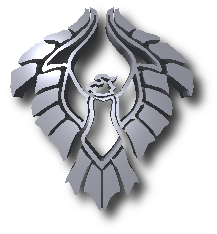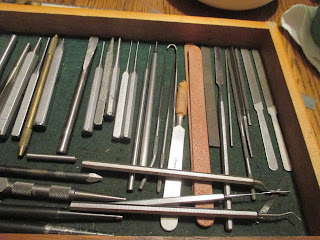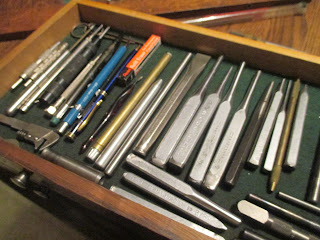So, on to the tool box. It has definitely seen better days. I don't really want to refinish it, though. It is beautiful.
Next, I did a little drawer organization. Starting from the bottom, I found end mills, cutting inserts, lathe bits, set screws, ball bearings, hex wrenches and boring bars. I also found a weird little measuring device that I am unfamiliar with :
Next one up had punches, chisels, files, pencils/pen, and a the usual marking supplies along with a demurring tool set :
The third drawer from the bottom had a few clamps, a 0-1" outside micrometer (Geo Scherr Company), a 1-2" outside micrometer, dividers, compass, a few needle points that I am unfamiliar with, and an old pin chuck :
Next, we'll tackle the left drawers. The bottom of the left side drawers contained some machinist jacks, v-blocks, clamps, and a little machinist vice. One cool thing out of that drawer was a portable oiler, shown in the middle of this next picture :
Next was a bunch of taps (some custom ground for specific purposes) :
And then, in the top-most drawer on the left side, tap wrenches and a few dies (along with a random chuck key). The cool thing was this tool box owner built his own die using a nut and either a mill or a drill :
Next, I went to the right side, starting from the bottom-misty right-handed drawer. It was full of center drills, drill bits for a chuck, and drill bits for a morse taper (1MT). It was just getting better all the time.
Next came with some solder, stones, o-rings, and some other odds and ends. I am interested to know who "Carla" was - written on one of the measuring rulers found here :
Two left! Next one on the right side was full of gear pitch gauges, feeler gauges, and other measuring tools. This owner was definitely organized :
One thing in this drawer I was unfamiliar with was a craftsman tool looking like :
So, onward and upward. The last drawer was filled with bushings, pins, welding tips, a couple of springs, and some rather weird stuff. It also had two pieces of what looked like part of a sine bar, and four small parallels :
Finally, to the top. This was a bit of a score in and of itself. There were two squares, three micrometer stands, a small micrometer, a small mechanical micrometer, angle finders, an alignment device (Tubalcain/mrpete222 called it a "wobbler", and I am not sure of the official name), parallels/gauge blocks, and some right-angle blocks :
Yes, I think I scored. For a grand total of $350, I ended up with four micrometers, three micrometer stands, rulers, alignment pins, drill bits, v-blocks, jacks, taps, dies, end mills, lathe cutting bits, inserts, set screws, dividers, and a host of other things I've already forgotten.














































